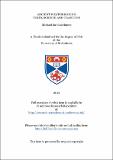Files in this item
Ancient weather signs : texts, science and tradition
Item metadata
| dc.contributor.advisor | Gee, Emma Ruth Grenville | |
| dc.contributor.author | Beardmore, Michael Ian | |
| dc.coverage.spatial | vi, 226 p. | en_US |
| dc.date.accessioned | 2013-10-17T14:08:22Z | |
| dc.date.available | 2013-10-17T14:08:22Z | |
| dc.date.issued | 2013 | |
| dc.identifier | uk.bl.ethos.581829 | |
| dc.identifier.uri | https://hdl.handle.net/10023/4103 | |
| dc.description.abstract | This thesis offers a new contextualisation of weather signs, naturally occurring terrestrial indicators of weather change (from, for example, animals, plants and atmospheric phenomena), in antiquity. It asks how the utility of this method of prediction was perceived and presented in ancient sources and studies the range of answers given across almost eight hundred years of Greek and Roman civilisation. The presentation of weather signs is compared throughout to that of another predictive method, astrometeorology, which uses the movement of the stars as markers of approaching weather. The first chapter deals with the presentation and discussion of weather signs in a range of Greek texts. It sees hesitant trust being placed in weather signs, lists of which were constructed so as to be underpinned by astronomical knowledge. The second chapter assesses how these Greek lists were received and assimilated into Roman intellectual discourse by looking to the strikingly similar practice of divining by portents. This lays the foundations for the final chapter, which describes and explains the Roman treatment of weather signs. Here, the perceived utility of weather signs can be seen to reduce rapidly as the cultural significance of astronomy reaches new heights. This thesis provides new readings and interpretations of a range of weather-based passages and texts, from the Pseudo-Theophrastan De Signis, to Lucan’s Pharsalia, to Pliny’s Natural History, many of which have previously been greatly understudied or oversimplified. It allows us to understand the social and scientific place of weather prediction in the ancient world and therefore how abstract and elaborate ideas and theories filtered in to the seemingly commonplace and everyday. I argue that between the 7th century BC and the end of the 1st century AD, the treatment of weather signs changes from being framed in fundamentally practical terms to one in which practical considerations were negligible or absent. As this occurred, astrometeorology comes to be seen as the only predictive method worthy of detailed attention. These two processes, I suggest, were linked. | en_US |
| dc.language.iso | en | en_US |
| dc.subject | Weather signs | en_US |
| dc.subject | Aratus | en_US |
| dc.subject | Ancient meteorology | en_US |
| dc.subject | De signis | en_US |
| dc.subject | Georgics | en_US |
| dc.subject | Columella | en_US |
| dc.subject | Astrometeorology | en_US |
| dc.subject | Parapegma | en_US |
| dc.subject | Germanicus | en_US |
| dc.subject.lcc | QC998.B4 | |
| dc.subject.lcsh | Weather--Folklore--Greece--History | en_US |
| dc.subject.lcsh | Weather--Folklore--Rome--History | en_US |
| dc.subject.lcsh | Weather forecasting--Greece--History | en_US |
| dc.subject.lcsh | Weather forecasting--Rome--History | en_US |
| dc.subject.lcsh | Astrometeorology | en_US |
| dc.subject.lcsh | Weather in literature | en_US |
| dc.subject.lcsh | Classical literature | en_US |
| dc.subject.lcsh | Science, Ancient | en_US |
| dc.title | Ancient weather signs : texts, science and tradition | en_US |
| dc.type | Thesis | en_US |
| dc.type.qualificationlevel | Doctoral | en_US |
| dc.type.qualificationname | PhD Doctor of Philosophy | en_US |
| dc.publisher.institution | The University of St Andrews | en_US |
This item appears in the following Collection(s)
Items in the St Andrews Research Repository are protected by copyright, with all rights reserved, unless otherwise indicated.

